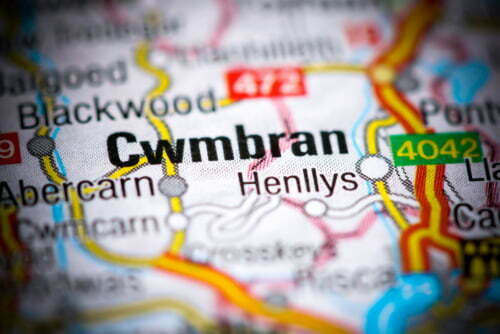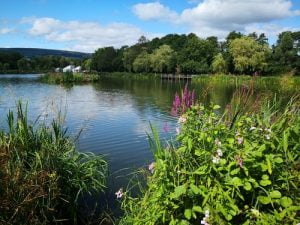
Cwmbran in Brief
Cwmbran is a town in the county borough of Torfaen in Southeast Wales. The town lies around 6 miles (10 km) north of Newport and about 14 miles (23 km) northeast of the Welsh capital, Cardiff. The ‘new town’ of Cwmbran was established in 1949, formed from the villages of Old Cwmbran, Pontnewydd, Upper Cwmbran, Croesyceiliog, Llantarnam, and Llanyrafonwith. The idea behind the newly formed town was to bring employment opportunities to that area, following the devastation of the Second World War. In 2020, the town’s population was estimated at 48,890.

Aerial view of Cwmbran. Image credit: steved_np3/Shuttertock.com
A Fleeting History of Cwmbran
Early Times
Although Cwmbran is today known as a post-war ‘new town’, archaeological evidence suggests that the area has been occupied since the Neolithic times. The Romans were also present in the area after their first-century invasion of Britain, establishing forts at nearby Usk (Burrium) and Caerleon (Isca Augusta).
After the Romans withdrew from the area at the end of the 3rd century, the recorded history of the Cwmbran area is somewhat scant. However, it is known that around 1179, Hywel, Lord of Caerleon, gifted money and land for the foundation of a Cistercian Abbey at Llantarnam. The Abbey remained functional up until the enactment of Henry VIII’s Dissolution of the Monasteries in 1536.
The Birth of Cwmbran
The Abbey and adjoining land passed through a succession of wealthy landowners. Sometime during the 18th century, the estate passed into the possession of the Blewitt family. Local businessman, Reginald Blewitt, restored the Abbey and used it as a family home, adding the Great Hall. Through the 19th century, the Blewitts were also largely responsible for the continuing heavy industrial development of the Cwmbran area. They established brick making, lime kilns, iron ore mining, coal mining, and quarrying were established during this period along with a canal to transport goods to the docks at Newport.
In 1833, the area now known as Cwmbran was almost entirely farmland. It was situated in a vale known as Cwm Bran, which translates from Welsh as ”Valley of the Crows”. However, in the early 1840s, extraction of both coal and iron ore began at Mynydd Maen in Upper Cwm Bran. Brickworks, lime kilns, and quarries were all set up following the establishment of mining. Later in the 19th-century tinworks, iron foundries and coke works were all in operation.
Growth Spurt
Terraced houses were quickly constructed near the industrial site to provide homes for workers. In 1842, an Elim Congregational chapel was founded. The village that proceeded to grow around the works took the ‘Cwmbran’ name. The industrialisation of the Cwmbran area also spurred the construction of local transportation. The first railway station in (Old) Cwmbran was opened by the Monmouthshire Railway and Canal Company in July 1852. The station closed on 11 March 1880 but the Great Western Railway (GWR) opened a new terminus at Cwmbran on the same day.
By the early 19th century, Cwmbran had become a significant industrial centre. It was described by one writer of the time as ”a grimy place, abounding in factories, furnaces, and rolling mills.” After World War One, the mines in Cwmbran began to close, which led to the area suffering huge unemployment and poverty.
A ‘New Town’ Proposal
Following the end of World War Two in 1945, a New Towns Commission was set up by the UK government. The Commission was tasked with looking at the viability of ‘New Towns’ as a structured instrument for post-war development. The board’s recommendations led to the passing of the New Towns Act of 1946. Ministries and local governments across the country were then asked to propose new town sites.
For Wales, the Ministry of Housing and Local Government nominated Church Village in Glamorgan, and Cwmbran in Monmouthshire. However, the Church Village proposal was vetoed by the Ministry of Power. This was on the grounds that new housing would interfere with the planned expansion of coal mining operations in the area. Thus, Cwmbran became one of the twenty-two proposed ‘New Towns’ in the country, and the only one in Wales.
The Development of ‘New’ Cwmbran
On 4 November 1949, an area of 3,160 acres (1,280 ha) around (Old) Cwmbran, Pontnewydd and Croes-y-ceiliog was designated as the site for the ‘new town’ of Cwmbran. Three weeks later the Cwmbran Development Corporation was established. The authority’s main objectives were to develop the town, provide housing, and make appropriate social and commercial provisions for its residents.
In March 1950, Minoprio & Spencely and PW Macfarlane were appointed as town planning consultants. The proposal was for seven residential areas, each with its own neighbourhood centre. The town’s leisure facilities even included a 5-acre (20,000 m2) boating lake. Light industry and retail parks replaced the old mines and quarried areas. One negative was the closure of the station at Old Cwmbran on the GWR line in 1962. Nonetheless, by 1970, the new town’s population had reached 33,000.

Cwmbran’s boating lake. Image credit: Scp photography/Shutterstock.com
Present Day Cwmbran
Today, Cwmbran has a population of almost 50,000 and has developed into one of South Wales’s most popular shopping centres. The present-day Cwmbran railway station opened in 1986 on the Welsh Marches Line. It mainly functions as a commuter to Newport and Cardiff but also brings in shoppers to the town.
Cwmbran’s biggest employer is the Burton Biscuit Co. which employs over 800 people at their Llantarnam factory. The plant produces some of the company’s most iconic brands such as wagon wheels, chocolate fingers and jammy dodgers. The pedestrianised town centre houses more than 170 shops.
During the summer the town hosts the very popular annual Cwmbran Big Event at the Boating Lake. The fun day out is a mix of culture, entertainment, and fun sporting events.
Cwmbran is twinned with Bruchsal in Baden-Württemberg, Germany.
Getting to Cwmbran
By Road
It’s fairly straightforward getting to Cwmbran by road. From London and the South East take the M4 all the way to Newport. Next, turn on to the A4042, the turning for Cwmbran is only a couple of miles away. From the North and the Midlands, take the M5 as far as Almondsbury, then turn onto the M4.
By Train
Cwmbran railway station lies on the Welsh Marches Line. There are regular southbound trains to Newport and Cardiff, and northbound to Pontypool and Abergavenny. Longer distance services run to Hereford, Shrewsbury, Crewe, Holyhead, and Manchester.
By Air
The nearest airports to Cwmbran are Cardiff which is 33 miles away, and Bristol, which is 38 miles.
A Notable Son

Cwmbran hero John Fielding. Image credit: Wikipedia
John Fielding (aka John Williams) VC, the second eldest of ten children, was born in Abergavenny in 1857. In 1887, he enlisted in the Monmouthshire Militia, under the non-de-plume of John Williams. Aged 21, Private Fielding found himself serving in the 2nd Battalion, 24th Regiment of Foot of the British Army during the Anglo-Zulu War.
He was awarded a Victoria Cross for an act of heroism that took place on 22–23 January 1879 at Rorke’s Drift, Natal, South Africa. Despite overwhelming odds, Private Fielding and two other men held back Zulu forces at a local hospital, enabling the rescue of eight patients. He was presented with the VC in Gibraltar by Major-General Anderson, Governor of Gibraltar, in 1880.
John Fielding married in 1884 and went on to father 3 sons and 3 daughters. He lived the greater part of his life in Cwmbran, dying there from heart failure on 24 November 1932. He was buried in St Michael’s churchyard in Llantarnam, Cwmbran. His headstone acknowledges his heroic act at Rorke’s Drift and his receipt of the Victoria Cross. Fielding’s act of heroism was immortalised in the 1961 film, Zulu, starring Stanley Baker and Michael Caine.
The nursing home directly opposite Fielding’s burial place has been eponymously named in his honour. A pub in Cwmbran, The John Fielding, also bears his name. John Fielding’s medal is on display at the Royal Welsh Regimental Museum, located at Brecon, about 35 miles northwest of Cwmbran.
Sport in Cwmbran
Football
Cwmbran Town FC
Cwmbrân Town Football Club competes in the Gwent County League Premier Division, the fourth tier of the Welsh football league system. Nicknamed ‘The Crows’, the team plays home games at the 10,500-capacity Cwmbran Stadium.
Cwmbran Celtic FC
Cwmbran Celtic Football Club plays in the Cymru South League which forms the second tier of the Welsh football league system. Nicknamed ‘The Yellows’, the team plays home games at the 700-capacity Celtic Park.
Croesyceiliog AFC
Croesyceiliog Association Football Club plays in the Ardal Leagues South East, the third tier of the Welsh football league system. They play home games at Woodland Road.
Rugby
Cwmbran RFC
Cwmbran Rugby Football Club is a rugby union team that plays in the WRU Division 2 East. Nicknamed ‘The Crows’, they play home games at the King’s Head Ground.
Croesyceiliog RFC
Croesyceiliog Rugby Football Club is a rugby union team that plays in plays in the WRU Division 1 East. Nicknamed ‘The Cockerels’, they play home games at Woodland Road.
Torfaen Tigers
Torfaen Tigers are a rugby league team that plays in the 4th tier of the British rugby league system; the Conference League South. They play their home games at the Kings Head Ground.
Places to see in Cwmbran
Isca Roman Fort
The Roman fort of Isca (aka Isca Augusta) was once home to some 5,000 legionnaires that made up the 2nd Augustan Legion. You can visit the remains of the fort, which includes the amphitheatre, barracks, and baths, at the Caerleon site about 5 miles northwest of Cwmbran. An audio-visual tour is available to help you get the most from your visit.
Llantarnam Grange Arts Centre
The Centre, run as a charity, hosts contemporary art and craft exhibitions throughout the year. The craft shop showcases a range of jewellery, ceramics, textiles, cards, sculptures, etc., from artists throughout Wales. There’s also a decent cafe on site.
Llantarnum Abbey
Llantarnum Abbey was founded in the 12th century by Cistercian monks. A local influential family, the Blewitts, converted the abbey into a family home in the early 19th century. The Abbey eventually passed to the government but was then sold on to the Sisters of St Joseph in 1946.
The grounds include a medieval tithe barn, a chapel, a walled garden, and a labyrinth. The abbey itself is not usually open to visitors but you are welcome to visit the chapel.
Things to do in Cwmbran
Cwmbran Boating Lake
Cwmbran Boating Lake is only a few minutes walk from Cwmbran town centre. The expansive park actually features two lakes. The larger lake is a sanctuary to wetland birds, while the small one is the actually boating lake. The park also houses a large adventure playground, a skate park, various sports pitches and a café.
Take a Hike!
The hills that surround Cwmbran rise to over 1000 feet and are popular with both walkers and climbers. A popular local walk is a 6-mile leisurely hike southwestwards to Twmbarlwm Hillfort. For those looking for a bigger challenge, the (Welsh) Cistercian Way passes through Old Cwmbran en route. The 672-mile-long circular pathway officially starts and ends in Caerphilly, South Wales.
Anyone for Golf?
The Greenmeadow Golf and Country Club is located on the outskirts of Cwmbran. The superb course is complemented by a driving range, golf shop, saunas, and a gym.
Where to Stay?
There are fairly limited accommodation choices within and around Cwmbran itself. Newport, around 4 miles away, and Pontypool, about 6 miles away, offer a much greater choice of stay options.
Moving to Cwmbran?
Thinking of moving to Cwmbran? The overall average property price in the Cwmbran area for the year leading up to April 2022 stood at approximately £200,900. This was very similar to the average price paid in the previous year. In terms of property types, terraced houses were the best-sellers at an average of £158,800. Flats sold for an average of £91,000, semi-detached for £193,500, and detached for £296,800.
Thinking of a Staycation?
Are you thinking of holidaying in the UK? If so, why not check out some of our other travel guides for some staycation ideas? I think you might be surprised at the variety of great things to do in the UK.
Header image credit: SevenMaps/Shutterstock.com
Why not take our Cwmbran trivia quiz?
Quiz Maker – powered by Riddle
